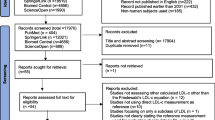Abstract
The high correlation between apolipoprotein B (apoB) and non-high-density lipoprotein cholesterol (non-HDL-C) is the chief argument employed against introducing apoB into clinical practice. However, high correlation does mean that non-HDL-C and apoB will often yield similar clinical information. Nevertheless, the critical issue is not how often the two tests agree, but how often, and how substantially, they differ. In other words, how often would an apoB result change a clinical decision based on a value for non-HDL-C? This article presents a series of examples from prominent published studies in which apoB and non-HDL-C differ so dramatically that diagnosis and therapy would truly differ depending on which index was used by the physician. These examples establish that apoB and non-HDL-C are not clinical equivalents.
Similar content being viewed by others
References and Recommended Reading
Glasziou P, Irwig L, Deeks JJ: When should a new test become the current reference standard? Ann Intern Med 2008, 149:816–821.
NHANES Investigators: National Health and Nutrition Examination Survey (NHANES 2005–2006). Available at http://www.cdc.gov/nchs/data/nhanes/nhanes_05_06/nhanes_2005_2006_codebook_description.pdf. Accessed February 16, 2009.
Sniderman AD, Hogue JC, Bergeron J, et al.: Non-HDL cholesterol and apoB in dyslipidaemia. Clin Sci (London) 2008, 114:149–155.
Sattar N, Williams K, Sniderman AD, et al.: Comparison of the associations of apolipoprotein B and non-high-density lipoprotein cholesterol with other cardiovascular risk factors in patients with the metabolic syndrome in the Insulin Resistance Atherosclerosis Study. Circulation 2004, 110:2687–2693.
Sniderman AD, Tremblay A, Bergeron J, et al.: Diagnosis of type III hyperlipoproteinemia from plasma total cholesterol, triglyceride, and apolipoprotein B. J Clin Lipidol 2007, 1:256–263.
Ridker PM, Danielson E, Fonseca FA, et al.; JUPITER Study Group: Rosuvastatin to prevent vascular events in men and women with elevated C-reactive protein. N Engl J Med 2008, 359:2195–2207.
de Graaf J, Couture P, Sniderman AD: A diagnostic algorithm for the atherogenic apolipoprotein B dyslipoproteinemias. Nature Clin Pract 2008, 4:608–611.
Goldstein JL, Schrott HG, Hazzard WR, et al.: Hyperlipidemia in coronary heart disease. II. Genetic analysis of lipid levels in 176 families and delineation of a new inherited disorder, combined hyperlipidemia. J Clin Invest 1973, 52:1544–1568.
Veerkamp MJ, de Graaf J, Hendriks JC, et al.: Nomogram to diagnose familial combined hyperlipidemia on the basis of results of a 5 year follow-up study. Circulation 2004, 109:2980–2985.
Wiesbauer F, Blessberger H, Azar D, et al.: Familial-combined hyperlipdaemia in very young myocardial infarction survivors (≤40 years of age). Eur Heart J 2009 Mar 10 (Epub ahead of print).
Genest J Jr, Bard JM, Fruchart JC, et al.: Familial hypoalphalipoproteinemia in premature coronary artery disease. Arterioscler Thromb 1993, 13:1728–1737.
El Harchaoui K, Arsenault BJ, Franssen R, et al.: High-density lipoprotein particle size and concentration and coronary risk. Ann Intern Med 2009, 150:84–93.
Sniderman AD, Zhang Z, Genest J, Cianflone K: Effects on apoB-100 secretion and bile acid synthesis by redirecting cholesterol efffux from HepG2 cells. J Lipid Res 2003, 44:527–532.
Sniderman AD: Differential response of cholesterol particle measures of atherogenic lipoproteins to LDL-lowering therapy: implications for clinical practice. J Clin Lipidol 2008, 2:36–42.
Kastelein JJ, van der Steeg WA, Holme I, et al.; TNT Study Group, IDEAL Study Group: Lipids, apolipoproteins, and their ratios in relation to cardiovascular events with statin treatment. Circulation 2008, 117:3002–3009.
Marcovina SM, Albers JJ, Kennedy H, et al.: International Federation of Clinical Chemistry standardization project for measurements of apolipoproteins A–I and B. IV. Comparability of apolipoprotein B values by use of International Reference Material. Clin Chem 1994, 40:586–592.
Author information
Authors and Affiliations
Corresponding author
Rights and permissions
About this article
Cite this article
Sniderman, A., Williams, K. & Cobbaert, C. ApoB versus non-HDL-C: What to do when they disagree. Curr Atheroscler Rep 11, 358–363 (2009). https://doi.org/10.1007/s11883-009-0054-2
Published:
Issue Date:
DOI: https://doi.org/10.1007/s11883-009-0054-2




